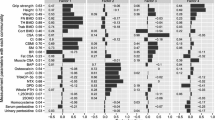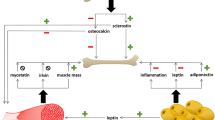Abstract
Radiologic measurements of bone mineral mass in the proximal radius, muscle width and thickness of the subcutaneous fat of the forearm were studied in normal men and women throughout the adult age range. Bone mineral mass showed no significant change to age 60 in men and age 50 in women, but fell thereafter. Muscle width declined from age 30 in the male population, though no significant reduction was found in women before age 60. The correlations between these variables also differed between males and females. While bone mineral mass and muscle width tended, in males, to be positively correlated at all ages, in females no significant correlation was found after age 60. In females, however, bone mass and subcutaneous fat were distinctly correlated in the over 60 age group, though no significant correlation was found in males in any age group. In an osteoporotic group, bone mineral mass and muscle width were lower in male patients than in normals of similar age. In female osteoporotic patients, however, while bone mineral mass and subcutaneous fat were less than in normals, muscle width showed no difference.
Résumé
Des mesures radiologiques de la masse minérale osseuse de la partie proximale du radius et l'épaisseur du muscle et du tissu graisseux sous-cutané de l'avant-bras ont été relevées chez l'homme et la femme adultes normaux. La masse minérale osseuse ne montre pas de modification significative jusqu'à 60 ans chez l'homme et 50 ans chez la femme, puis on observe une chute. L'épaisseur musculaire décroit, chez l'homme, à partir de 30 ans, alors que chez la femme on n'observe aucune modification significative avant 60 ans. Les corrélations entre ces variables diffèrent selon le sexe. Alors que la masse minérale et l'épaisseur musculaire varient positivement chez l'homme en fonction de l'âge, il n'y a pas de rapport significatif chez la femme, après 60 ans. Cependant, chez ces dernières, la masse osseuse et le tissu graisseux sous-cutané sont en corrélation nette après 60 ans, bien qu'aucun rapport significatif ne soit noté chez l'homme quel que soit le groupe d'âge. Chez des sujets ostéoporotiques, la masse minérale osseuse et l'épaisseur musculaire sont plus faibles chez les hommes par rapport à des sujets normaux du même âge. Chez des femmes ostéoporotiques, cependant, bien que la masse minérale osseuse et le tissu graisseux sous-cutané soient inférieures par rapport à des sujets normaux, l'épaisseur du muscle n'est pas modifiée.
Zusammenfassung
Es wurden bei gesunden erwachsenen Männern und Frauen radiologische Messungen der Knochenmineralmasse im proximalen Radius, der Dicke des Muskels und des subkutanen Fettes des Vorderarmes durch die ganze Altersspanne durchgeführt. Die Knochenmineralmasse zeigte keine signifikante Veränderung bis zum 60. Altersjahr bei den Männern und bis zum 50. Altersjahr bei den Frauen; dann jedoch sank sie ab. Die Muskeldicke nahm bei den Männern über 30 Jahren ab, bei den Frauen konnte jedoch eine signifikante Abnahme erst ab 60 Jahren festgestellt werden. Die Korrelation zwischen diesen beiden Werten war bei Männern und Frauen ebenfalls verschieden. Während bei den Männern Knochenmineralmasse und Muskeldicke in jedem Alter meistens eine positive Korrelation zeigte, konnte bei den Frauen nach dem 60. Altersjahr keine signifikante Korrelation gefunden werden. Bei den Frauen zeigten hingegen Knochenmasse und subkutanes Fett eine deutliche Korrelation in der Gruppe nach dem 60. Altersjahr, während bei den Männern in keiner Altersgruppe eine signifikante Korrelation gefunden werden konnte. In einer osteoporotischen Gruppe waren Knochenmineralmasse und Muskeldicke niedriger bei Männern, verglichen mit Kontrollen bei Gesunden desselben Alters. Bei weiblichen osteoporotischen Patienten hingegen zeigte die Muskeldicke keinen Unterschied, während Knochenmineralmasse und subkutanes Fett niedriger waren als bei Gesunden.
Similar content being viewed by others
References
Brozek, J., Mori, H.: Some interrelations between somatic, roentgenographic and densitometric criteria of fatness. Hum. Biol.30, 322–336 (1958).
Coppage, W. S., Jr., Cooner, A. E.: Testosterone in human plasma. New Engl. J. Med.273, 902–907 (1965).
Deitrick, J. E., Whedon, G. D., Shorr, E.: Effects of immobilization upon various metabolic and physiologic functions of normal men. Amer. J. Med.4, 3–36 (1948).
Dent, C. E., Watson, L.: Osteoporosis. Postgrad. med. J., Suppl.42, 581–609 (1966).
Doyle, F., Brown, J., Lachance, C.: Relation between bone mass and muscle weight. Lancet1970 I, 391–393.
Frost, H. M.: Bone dynamics in osteoporosis and osteomalacia, p. 74–78. Springfield: Ch. C. Thomas 1966.
Garn, S. M.: Roentgenogrammetric determinations of body composition. Hum. Biol.29, 337–353 (1957).
Garn, S. M.: The earlier gain and the later loss of cortical bone in nutritional perspective, p. 77–80. Springfield: Ch. C. Thomas 1970.
Garn, S. M., Rohmann, C. G., Nolan, P., Jr.: The developmental nature of bone changes during aging. In: Relations of development and aging, ed. J. E. Birren, p. 41–61. Springfield: Ch. C. Thomas 1964.
Geiser, M., Trueta, J.: Muscle action, bone rarefaction and bone formation. An experimental study. J. Bone Jt Surg. B40, 282–311 (1958).
Gordan, G. S.: Recent progress in calcium metabolism: Clinical application. Calif. Med.114, 28–43 (1971).
Harris, W. H., Heaney, R. P.: Skeletal renewal and metabolic bone disease. New Engl. J. Med.280, 303–311 (1969).
Iskrant, A. P., Smith, R. W., Jr.: Osteoporosis in women 45 years and over related to subsequent fractures. Publ. Hlth Rep.84, 33–38 (1969).
Johnston, C. C., Jr., Smith, D. M., Pao-Lo Yu, Deiss, W. P., Jr.:In vivo measurement of bone mass in the radius. Metabolism17, 1140–1153 (1968).
Meema, H. E.: Cortical bone atrophy and osteoporosis as a manifestation of aging. Amer. J. Roentgenol.89, 1287–1295 (1963).
Meema, H. E.: Menopausal and aging changes in muscle mass and bone mineral content. J. Bone Jt Surg. A48, 1138–1144 (1966).
Meema, H. E., Bunker, M., Meema, S.: Loss of compact bone due to menopause. Obstet. and Gynec.26, 333–343 (1965).
Meema, H. E., Harris, C. K., Porrett, R. E.: A method for determination of bone-salt content of cortical bone. Radiology82, 986–997 (1964).
Meema, H. E., Meema, S.: Measurable roentgenologic changes in some peripheral bones in senile osteoporosis. J. Amer. Geriat. Soc.11, 1170–1182 (1963).
Meema, H. E., Meema, S.: The relationship of diabetes mellitus and body weight to osteoporosis in elderly females. Canad. med. Ass. J.96, 132–139 (1967).
Morgan, D. B., Spiers, F. W., Pulvertaft, C. N., Fourman, P.: The amount of bone in the metacarpal and the phalanx according to age and sex. Clin. Radiol.18, 101–108 (1967).
Newton-John, H. F., Morgan, D. B.: The loss of bone with age, osteoporosis, and fractures. Clin. Orthop.71: 229–252 (1970).
Nilsson, B. E. R.: Post-traumatic osteopenia. Acta orthop. scand., Suppl.91, 1–47 (1966).
Nordin, B. E. C.: Bone patterns in aging and osteoporosis. In: Proceedings of Conference: Progress in methods of bone mineral measurement, Bethesda, Md. Feb. 15–17, 1968, ed. D. G. Whedon and J. R. Cameron, p. 159–175. Bethesda, Md.: HEW 1970.
Nordin, B. E. C., MacGregor, J., Smith, D. A.: The incidence of osteoporosis in normal women: its relation to age and the menopause. Quart. J. Med., New Ser.35, 25–38 (1966).
Saville, P. D.: Changes in bone mass with age and alcoholism. J. Bone Jt Surg. A47, 492–499 (1965).
Saville, P. D., Nilsson, B. E. R.: Height and weight in symptomatic postmenopausal osteoporosis. Clin. Orthop.45, 49–54 (1966).
Saville, P. D., Whyte, M. P.: Muscle and bone hypertrophy. Positive effect of running exercise in the rat. Clin. Orthop.65, 81–88 (1969).
Schmidt, H.: Testosteroneausscheidung bei männlichen Personen unter normalen und pathologischen Bedingungen. Acta endocr. (Kbh.), Suppl.128, 1–64 (1968).
Virtama, P., Helelä, T.: Radiographic measurements of cortical bone. Acta radiol. (Stockh.), Suppl.293, 1–268 (1969).
Whedon, G. D.: Symposium comment. In: Osteoporosis, ed. U. S. Barzel, p. 266–272. New York: Grune & Stratton 1970.
Author information
Authors and Affiliations
Additional information
This study was supported by Canadian Medical Research Council Grant MA-3889.
Rights and permissions
About this article
Cite this article
Meema, S., Reid, D.B.W. & Meema, H.E. Age trends of bone mineral mass, muscle width, and subcutaneous fat in normals and osteoporotics. Calc. Tis Res. 12, 101–112 (1973). https://doi.org/10.1007/BF02013725
Received:
Accepted:
Issue Date:
DOI: https://doi.org/10.1007/BF02013725




